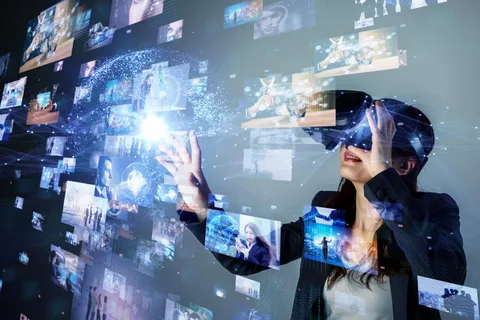I. Introduction
The fashion industry, known for its dynamism and creativity, is undergoing a digital revolution, with Artificial Intelligence (AI) taking center stage. Virtual fashion shows, facilitated by AI technologies, are reshaping how designers showcase their collections and how audiences engage with the world of fashion. This article explores the pivotal role of AI in virtual fashion shows, examining the innovative ways in which technology is transforming the runway experience.
II. Virtual Fashion Shows: A Digital Evolution
Traditional fashion shows, while glamorous, are limited by physical constraints. This section introduces the concept of virtual fashion shows as a digital evolution. AI plays a crucial role in translating the vibrancy and spectacle of physical runways into immersive and accessible virtual experiences.
III. AI-Generated Models and Avatars
One of the key contributions of AI to virtual fashion shows is the creation of digital models and avatars. This section explores how AI algorithms can generate realistic and diverse virtual models. Designers can leverage these avatars to showcase their creations in a virtual environment, allowing for greater experimentation with sizes, shapes, and aesthetics.
IV. Personalized Virtual Runway Experiences
AI tailors the virtual fashion show experience to individual preferences. This section delves into how AI algorithms analyze user data and engagement patterns to curate personalized virtual runways. Viewers can enjoy a customized showcase, enhancing their connection with the fashion brand and fostering a sense of exclusivity.
V. AI-Driven Fashion Design Assistance
AI extends its influence beyond presentation to the very process of fashion design. This section explores how AI algorithms can assist designers in generating innovative concepts, predicting trends, and even recommending design modifications. The synergy between human creativity and AI-driven insights contributes to the evolution of fashion design.
VI. Virtual Try-On Experiences
AI enhances the virtual fashion show experience by enabling virtual try-on features. This section discusses how viewers can use augmented reality (AR) applications powered by AI to virtually try on showcased garments. This interactive element bridges the gap between the virtual and physical worlds, providing a more immersive and engaging experience.
VII. Realistic Fabric Simulation
A significant challenge in virtual fashion shows is replicating the tactile experience of fabrics. This section explores how AI-driven realistic fabric simulation addresses this challenge. By accurately simulating the look and feel of different materials, designers and viewers alike can gain a more authentic understanding of the showcased garments.
VIII. AI for Predictive Analytics in Fashion
Predictive analytics powered by AI contributes to the success of virtual fashion shows. This section examines how AI algorithms analyze data from past shows, social media trends, and consumer behaviors to make predictions about future fashion trends. This foresight enables designers to create collections that resonate with evolving consumer preferences.
IX. Virtual Fashion Show Accessibility
AI plays a transformative role in making fashion more accessible. This section discusses how virtual fashion shows, facilitated by AI, break down geographical and physical barriers. Viewers from around the world can participate in real-time, democratizing access to high-profile fashion events.
X. Challenges and Ethical Considerations
Despite the advancements, challenges and ethical considerations exist in the integration of AI into virtual fashion shows. This section explores issues such as bias in AI algorithms, data privacy concerns, and the need for transparency in AI-driven processes. Responsible AI practices are essential for ensuring fair and ethical virtual fashion experiences.
XI. Future Innovations and Collaborations
The future of AI in virtual fashion shows holds exciting possibilities. This section emphasizes the potential for further innovations, including AI-generated fashion collections, collaborative design projects between humans and AI, and the evolution of virtual fashion show platforms. The collaboration between technology and creativity is poised to redefine the boundaries of the fashion industry.
XII. Conclusion
In conclusion, the role of AI in virtual fashion shows signifies a transformative shift in the fashion landscape. From AI-generated models and personalized experiences to virtual try-ons and predictive analytics, technology is reshaping how fashion is showcased and consumed. Embracing responsible AI practices ensures that virtual fashion shows not only captivate audiences but also uphold ethical standards in the ever-evolving world of fashion.
FAQs
- How does AI contribute to virtual fashion shows? AI contributes to virtual fashion shows by generating digital models and avatars, personalizing runway experiences, assisting in fashion design, enabling virtual try-ons, simulating realistic fabrics, and providing predictive analytics for future fashion trends.
- What is the role of AI in personalized virtual runway experiences? AI analyzes user data and engagement patterns to curate personalized virtual runways. This customization enhances viewers’ connections with fashion brands and creates a more exclusive and engaging virtual experience.
- How does AI assist in fashion design for virtual shows? AI algorithms assist designers in generating innovative concepts, predicting trends, and recommending design modifications. The collaboration between human creativity and AI-driven insights contributes to the evolution of fashion design.
- What challenges and ethical considerations are associated with AI in virtual fashion shows? Challenges include bias in AI algorithms, data privacy concerns, and the need for transparency. Ethical considerations involve ensuring fair and responsible AI practices to maintain ethical standards in virtual fashion experiences.
- What future innovations can be expected in the integration of AI into virtual fashion shows? Future innovations may include AI-generated fashion collections, collaborative design projects between humans and AI, and the evolution of virtual fashion show platforms. The collaboration between technology and creativity is poised to redefine the boundaries of the fashion industry.





